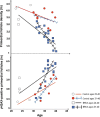BRCA-related ATM-mediated DNA double-strand break repair and ovarian aging
- PMID: 31822904
- PMCID: PMC6935693
- DOI: 10.1093/humupd/dmz043
BRCA-related ATM-mediated DNA double-strand break repair and ovarian aging
Abstract
Background: Oocyte aging has significant clinical consequences, and yet no treatment exists to address the age-related decline in oocyte quality. The lack of progress in the treatment of oocyte aging is due to the fact that the underlying molecular mechanisms are not sufficiently understood. BRCA1 and 2 are involved in homologous DNA recombination and play essential roles in ataxia telangiectasia mutated (ATM)-mediated DNA double-strand break (DSB) repair. A growing body of laboratory, translational and clinical evidence has emerged within the past decade indicating a role for BRCA function and ATM-mediated DNA DSB repair in ovarian aging.
Objective and rationale: Although there are several competing or complementary theories, given the growing evidence tying BRCA function and ATM-mediated DNA DSB repair mechanisms in general to ovarian aging, we performed this review encompassing basic, translational and clinical work to assess the current state of knowledge on the topic. A clear understanding of the mechanisms underlying oocyte aging may result in targeted treatments to preserve ovarian reserve and improve oocyte quality.
Search methods: We searched for published articles in the PubMed database containing key words, BRCA, BRCA1, BRCA2, Mutations, Fertility, Ovarian Reserve, Infertility, Mechanisms of Ovarian Aging, Oocyte or Oocyte DNA Repair, in the English-language literature until May 2019. We did not include abstracts or conference proceedings, with the exception of our own.
Outcomes: Laboratory studies provided robust and reproducible evidence that BRCA1 function and ATM-mediated DNA DSB repair, in general, weakens with age in oocytes of multiple species including human. In both women with BRCA mutations and BRCA-mutant mice, primordial follicle numbers are reduced and there is accelerated accumulation of DNA DSBs in oocytes. In general, women with BRCA1 mutations have lower ovarian reserves and experience earlier menopause. Laboratory evidence also supports critical role for BRCA1 and other ATM-mediated DNA DSB repair pathway members in meiotic function. When laboratory, translational and clinical evidence is considered together, BRCA-related ATM-mediated DNA DSB repair function emerges as a likely regulator of ovarian aging. Moreover, DNA damage and repair appear to be key features in chemotherapy-induced ovarian aging.
Wider implications: The existing data suggest that the BRCA-related ATM-mediated DNA repair pathway is a strong candidate to be a regulator of oocyte aging, and the age-related decline of this pathway likely impairs oocyte health. This knowledge may create an opportunity to develop targeted treatments to reverse or prevent physiological or chemotherapy-induced oocyte aging. On the immediate practical side, women with BRCA or similar mutations may need to be specially counselled for fertility preservation.
Keywords: BRCA; BRCA1/2; DNA repair; anti-Mullerian hormone; chemotherapy; mutations; oocyte; ovarian aging; ovarian reserve; ovarian response.
© The Author(s) 2019. Published by Oxford University Press on behalf of the European Society of Human Reproduction and Embryology. All rights reserved. For permissions, please e-mail: journals.permissions@oup.com.
Figures






Similar articles
-
BRCA Mutations, DNA Repair Deficiency, and Ovarian Aging.Biol Reprod. 2015 Sep;93(3):67. doi: 10.1095/biolreprod.115.132290. Epub 2015 Jul 29. Biol Reprod. 2015. PMID: 26224004 Free PMC article.
-
BRCA1/2 gene mutations do not affect the capacity of oocytes from breast cancer candidates for fertility preservation to mature in vitro.Hum Reprod. 2019 Feb 1;34(2):374-379. doi: 10.1093/humrep/dey358. Hum Reprod. 2019. PMID: 30561604
-
Impairment of BRCA1-related DNA double-strand break repair leads to ovarian aging in mice and humans.Sci Transl Med. 2013 Feb 13;5(172):172ra21. doi: 10.1126/scitranslmed.3004925. Sci Transl Med. 2013. PMID: 23408054 Free PMC article.
-
Increased chemotherapy-induced ovarian reserve loss in women with germline BRCA mutations due to oocyte deoxyribonucleic acid double strand break repair deficiency.Fertil Steril. 2020 Jun;113(6):1251-1260.e1. doi: 10.1016/j.fertnstert.2020.01.033. Epub 2020 Apr 22. Fertil Steril. 2020. PMID: 32331767 Free PMC article.
-
BRCA Mutations and Fertility Preservation.Int J Mol Sci. 2023 Dec 22;25(1):204. doi: 10.3390/ijms25010204. Int J Mol Sci. 2023. PMID: 38203374 Free PMC article. Review.
Cited by
-
Conditional loss of Brca1 in oocytes causes reduced litter size, ovarian reserve depletion and impaired oocyte in vitro maturation with advanced reproductive age in mice.EBioMedicine. 2024 Aug;106:105262. doi: 10.1016/j.ebiom.2024.105262. Epub 2024 Jul 30. EBioMedicine. 2024. PMID: 39084071 Free PMC article.
-
Gene Expression Profiling Elucidates Cellular Responses to NCX4040 in Human Ovarian Tumor Cells: Implications in the Mechanisms of Action of NCX4040.Cancers (Basel). 2022 Dec 31;15(1):285. doi: 10.3390/cancers15010285. Cancers (Basel). 2022. PMID: 36612280 Free PMC article.
-
Fertility Preservation in Young Women With Breast Cancer: A Review.J Breast Cancer. 2023 Jun;26(3):221-242. doi: 10.4048/jbc.2023.26.e28. J Breast Cancer. 2023. PMID: 37387349 Free PMC article. Review.
-
The crucial role of HFM1 in regulating FUS ubiquitination and localization for oocyte meiosis prophase I progression in mice.Biol Res. 2024 May 31;57(1):36. doi: 10.1186/s40659-024-00518-w. Biol Res. 2024. PMID: 38822414 Free PMC article.
-
Exploration of the mechanism and therapy of ovarian aging by targeting cellular senescence.Life Med. 2025 Jan 23;4(1):lnaf004. doi: 10.1093/lifemedi/lnaf004. eCollection 2025 Feb. Life Med. 2025. PMID: 40110109 Free PMC article. Review.
References
-
- Almeida CP, Ferreira MCF, Silveira CO, Campos JR, Borges IT, Baeta PG, Silva FHS, Reis FM, Del Puerto HL. Clinical correlation of apoptosis in human granulosa cells-a review. Cell Biol Int 2018;42:1276–1281. - PubMed
-
- Anaya Y, Tran ND. Delayed childbearing: impacts on fecundity and treatment. Med J Obstet Gynecol 2013;1:1009.
-
- Ashwood-Smith MJ. Edwards RG. DNA repair by oocytes. Mol Hum Reprod 1996;2:46–51. - PubMed
-
- Bedoschi GM, Navarro PA, Oktay KH. Novel insights into the pathophysiology of chemotherapy-induced damage to the ovary. Panminerva Med 2019;61:68–75. - PubMed
Publication types
MeSH terms
Substances
Grants and funding
LinkOut - more resources
Full Text Sources
Medical
Research Materials
Miscellaneous

